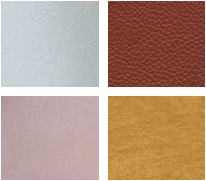
The properties of leather vary considerably depending upon the type and quality of both the skins and the tanning process. Every piece of leather has individual markings, which relate to its origins and add character to each skin.
A good quality leather garment should improve with age. The natural elasticity of each hide means it is flexible and will stretch and return to its original shape. Leather also has a natural tendency to repel liquids and resist staining. It's also fire-resistant, and emits no toxic fumes, even when exposed to intense heat.
Relative to virtually all man-made textiles, leather is very strong and has a high resistance level to tears and punctures. The comfort provided by most leather goods is due in part to leather's ability to combine breathing and insulating properties. And because it is a natural product, it adjusts constantly to its environment, allowing it to breathe freely, maintaining a comfort level in all seasons.
The difference between leather and suede? Suede is simply leather which is rubbed to make a velvety nap. It is also important to note that suede is made from splits, so it's a less expensive and less durable leather product.



